
No. 1 Air Ambulance Unit was a Royal Australian Air Force air ambulance unit of World War II. The unit was formed in February 1941 and was disbanded in June 1944 after seeing action in the Mediterranean Theatre of World War II.

No. 1 Air Ambulance Unit was a Royal Australian Air Force air ambulance unit of World War II. The unit was formed in February 1941 and was disbanded in June 1944 after seeing action in the Mediterranean Theatre of World War II.
No. 1 Air Ambulance Unit was formed on 15 February 1941 at RAAF Base Laverton and was equipped with three de Havilland DH-86 aircraft. The Unit left Australia for the Middle East in April 1941 and began flying from Gaza in August 1941. The unit supported Commonwealth units during the North African Campaign and Tunisia campaign from December 1941 until the end of the Tunisia campaign in May 1943. No. 1 Air Ambulance Unit was expanded and reequipped with 11 Bristol Bombay aircraft in February 1943. From July 1943 the unit supported the Allied invasion of Sicily and deployed to Italy in September 1943 to participate in the Italian Campaign.
Due to the availability of larger and faster medical evacuation aircraft operated by the Royal Air Force and United States Army Air Forces and the Bombays' mechanical problems No. 1 Air Ambulance Unit was withdrawn from service and flew its last evacuation mission in November 1943. The unit embarked for Australia in late February 1944 and was disbanded in Australia on 27 June 1944.

No. 3 Squadron is a Royal Australian Air Force (RAAF) fighter squadron, headquartered at RAAF Base Williamtown, near Newcastle, New South Wales. Established in 1916, it was one of four combat squadrons of the Australian Flying Corps during World War I, and operated on the Western Front in France before being disbanded in 1919. It was re-raised as a permanent squadron of the RAAF in 1925, and during World War II operated in the Mediterranean Theatre. The Cold War years saw the squadron disbanded and re-raised twice. It was based at RAAF Butterworth during the Malayan Emergency and the Indonesia–Malaysia Konfrontasi. Equipped with McDonnell Douglas F/A-18 Hornet multi-role fighters from 1986, the squadron deployed to Diego Garcia in 2002 to provide local air defence, and the following year contributed aircraft and crews to the invasion of Iraq as part of Operation Falconer. In April 2016, it deployed to the Middle East as part of the military intervention against ISIL.

No. 16 Air Observation Post Flight was a Royal Australian Air Force (RAAF) unit that saw action in World War II supporting Australian Army operations. It was formed in October 1944 and disbanded in June 1947. The flight was reestablished in September 1958, and was disbanded again in December 1960, when its responsibilities were transferred to a joint Army-RAAF unit.

No. 452 Squadron is a Royal Australian Air Force (RAAF) air traffic control unit. It was established in 1941 as a fighter squadron, in accordance with Article XV of the Empire Air Training Scheme during World War II. The squadron flew Supermarine Spitfires for the entire war, initially over the United Kingdom and Nazi-occupied Europe. It was later based in Australia and the Netherlands East Indies, before being disbanded in 1945. It was re-raised in its current role in February 2011.
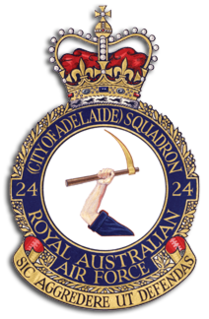
No. 24 Squadron is a Royal Australian Air Force squadron. The squadron was formed in 1940 and saw action as a bomber squadron during World War II serving in the Pacific theatre against the Japanese, and undertaking operations during the Battle of Rabaul, and the New Guinea, New Britain and Borneo campaigns. The squadron was disbanded in 1946 following the conclusion of hostilities, but was re-formed in 1951. From then until 2010 the squadron was an RAAF Reserve squadron located near Adelaide, South Australia; for part of this time, until 1960, the squadron continued to perform flying duties, before converting to a ground support role. In 2010, the squadron combined with Combat Support Unit Edinburgh to become a Permanent Air Force unit and it currently forms part of No. 96 Wing, Combat Support Group.
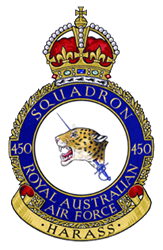
No. 450 Squadron was a unit of the Royal Australian Air Force (RAAF) that operated during World War II. Established at RAAF Station Williamtown, New South Wales, in February 1941, it was the first Australian Article XV squadron formed under the Empire Air Training Scheme.
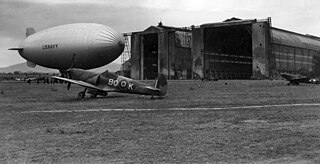
No. 451 Squadron was a Royal Australian Air Force army cooperation and fighter squadron of World War II. It was formed at Bankstown, New South Wales, on 12 February 1941 and began flying operations on 1 July as part of the North African Campaign in Egypt and Libya. No. 451 Squadron was withdrawn for refitting in early January 1942 and spent the remainder of the year performing garrison duties in Syria. In January 1943, it was transferred to Egypt to contribute to local air defence but saw almost no combat. This inactivity caused morale among the squadron's personnel to greatly deteriorate.
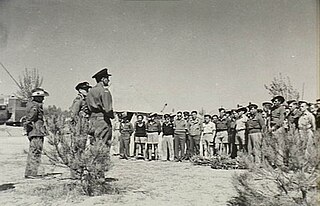
No. 454 Squadron was a unit of the Royal Australian Air Force (RAAF) that served during World War II. The squadron was raised in Australia under the Empire Air Training Scheme in mid-1941, but was disbanded shortly afterwards. It was re-formed later in 1941 from mainly British personnel and subsequently took part in the fighting in the Mediterranean and Middle East theatre before being disbanded in August 1945.

No. 21 Squadron is a Royal Australian Air Force (RAAF) general reserve squadron. Formed in the mid-1930s as a unit of the part-time Citizen Air Force (CAF), it was mobilised for service during World War II, when it saw action against the Japanese as a fighter unit in the Malayan campaign, a dive bomber unit in the New Guinea campaign, and a heavy bomber unit in the Borneo campaign. After the war, the squadron continued to fly until 1960, when the CAF ceased flying operations. At that time, No. 21 Squadron converted to a non-flying support role, which it currently fulfils at RAAF Williams.

No. 25 Squadron is a general reserve squadron of the Royal Australian Air Force (RAAF). It is based at RAAF Base Pearce in Perth, Western Australia, and forms part of the Combat Reserve Wing. The squadron was formed in early 1937 and until early 1939 was designated as "No. 23 Squadron". During World War II, it provided local air defence for the Perth region, before undertaking Army co-operation duties in 1943–1944 and then converting to the heavy bomber role in 1945. In the heavy bomber role, the squadron took part in operations against Japanese targets in the Netherlands East Indies and supported Allied ground operations during the Borneo Campaign.
No. 462 Squadron is a Royal Australian Air Force (RAAF) squadron which forms part of the Information Warfare Directorate in the RAAF's Air Warfare Centre. The squadron was first formed in 1942 as a heavy bomber unit and saw combat in this role in the Mediterranean area until it was disbanded in March 1944. It was reformed in the United Kingdom in August 1944 to participate in the bombing campaign against Germany, and in December that year converted to a specialist electronic warfare unit. No. 462 Squadron continued in this role until the end of the European war in May 1945 and was disbanded in September that year. The squadron was reformed in its current role during April 2005.
No. 52 Squadron was a Royal Air Force squadron that saw service in both World War I and World War II.

No. 17 Air Observation Post Flight was a Royal Australian Air Force artillery-spotting and liaison unit which saw action as part of the Bougainville campaign and New Britain campaign in World War II. The flight was established in October 1944 and disbanded in December the next year.
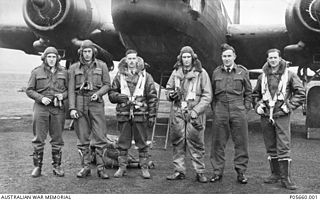
No. 458 Squadron RAAF was a Royal Australian Air Force squadron that operated during World War II. It was formed in Australia under Article XV of the Empire Air Training Scheme. The squadron flew various versions of Vickers Wellington bombers, first in Europe and later in the Middle East. It was disbanded in mid-1945, following the conclusion of hostilities in Europe.

No. 8 Squadron was an Australian flying training squadron of World War I and medium bomber squadron of World War II. The squadron was formed in England in October 1917 as part of the Australian Flying Corps, and disbanded in April 1919. It was re-formed by the Royal Australian Air Force in September 1939. After seeing action during the Pacific War flying Lockheed Hudson and, later, DAF Beaufort bombers, the squadron was disbanded a second time in January 1946.
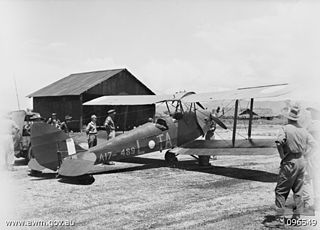
No. 10 Local Air Supply Unit was a Royal Australian Air Force air transport unit of World War II. No. 84 Wing was formed on 11 September 1944 in Cairns, Queensland. Commanded by Group Captain Bill Hely, it comprised No. 5 Squadron, No. 17 Air Observation Post (AOP) Flight, No. 10 Communication Unit, and No. 39 Operational Base Unit. The wing arrived at Torokina in October to begin supporting Australian troops during the Bougainville Campaign. 10 Communications Unit flew Avro Ansons and Bristol Beauforts on courier, reconnaissance, supply, and anti-malarial spraying missions; it was renamed No. 10 Local Air Supply Unit RAAF in March 1945. The Unit was also formed at Aitape, New Guinea on 18 April 1945 to undertake the local air supply of Australian Army units in New Guinea. The Unit here was equipped with a mix of Avro Anson, Bristol Beaufort and Tiger Moth aircraft and conducted supply and casualty evacuation flights until the end of the war. When the Pacific War ended in August 1945, No. 10 Local Air Supply Unit was tasked with dropping leaflets announcing the news over Japanese positions. Following the war No. 10 Local Air Supply Unit conducted courier flights to various locations in New Guinea until it was disbanded on 6 March 1946. 17 AOP Flight was disbanded on Bougainville in December, followed a month later by the Bougainville flight of No. 10 Local Air Supply Unit.

No. 2 Air Ambulance Unit RAAF was a Royal Australian Air Force air ambulance unit of World War II. The Unit was formed on 1 March 1942 at RAAF Base Fairbairn and flew its first operational sortie on 7 March. No. 2 Air Ambulance Unit operated throughout Australia during 1942 and began flights to New Guinea in 1943.

No. 112 Squadron was a squadron of the Royal Air Force. It served in both the First World War and Second World War and was active for three periods during the Cold War. It is nicknamed "The Shark Squadron", an allusion to the fact that it was the first unit from any Allied air force to use the famous "shark mouth" logo on Curtiss P-40s.
No. 243 Squadron was a flying squadron of the Royal Air Force. Originally formed in August 1918 from two flights that had been part of the Royal Naval Air Service, the squadron conducted anti-submarine patrols during the final stages of World War I. The squadron was later re-raised during World War II, operating initially as a fighter squadron in Malaya and Singapore during 1941–42. It was briefly disbanded just prior to the fall of Singapore, and was re-formed in mid-1942, again as a fighter squadron, and fought in the Tunisian and Italian campaigns in 1942–44, before being disbanded in October 1944. In 1945, after training on transport aircraft in Canada, the squadron moved to Australia where it operated in support of the British Pacific Fleet before disbanding in mid-1946.

No. 4 Service Flying Training School was a flying training school of the Royal Australian Air Force (RAAF) during World War II. It was formed in February 1941, and commenced flying the following month. Responsible for intermediate and advanced instruction of pilots under the Empire Air Training Scheme (EATS), the school was based at Geraldton, Western Australia, and operated Avro Anson aircraft. Two reserve squadrons were formed in response to the outbreak of war in the Pacific, though they never saw action. Flying activity was reduced towards the end of 1943, and the school was disbanded in May 1945, having graduated over 1,000 pilots. It re-formed as No. 87 Operational Base Unit, which was renamed Care and Maintenance Unit (CMU) Geraldton in May 1946. CMU Geraldton was disbanded in September 1947.
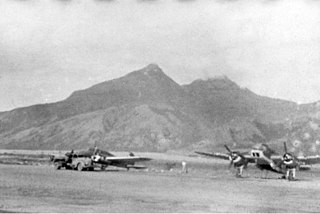
The Rescue and Communication Squadron was a Royal Australian Air Force (RAAF) squadron formed during World War II. Raised for service during the New Guinea campaign, the squadron existed between October 1942 and November 1943, and undertook a variety of support roles including search and rescue, transportation, reconnaissance and casualty evacuation. Upon disbandment, it was used to raise two new communications units.
British Pathé unused material featuring footage of No.1 Air Ambulance RAAF (3:11-4:06)
| This article about the military of Australia is a stub. You can help Wikipedia by expanding it. |